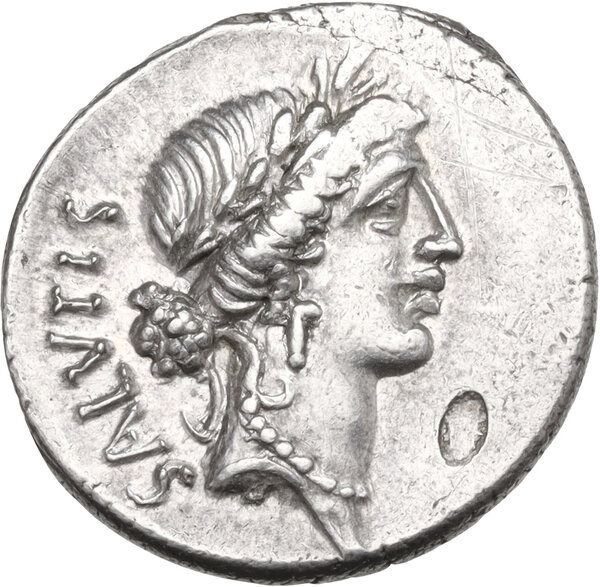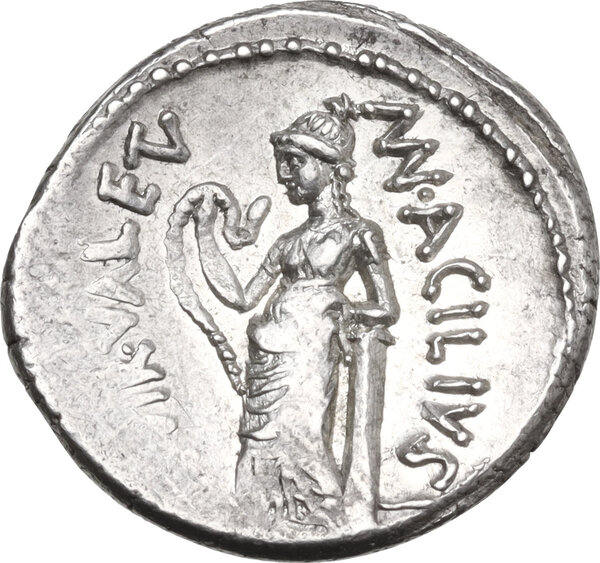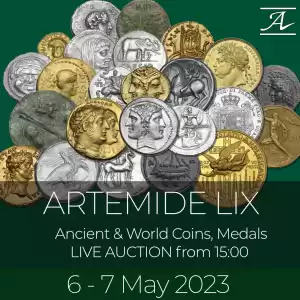From Este Collection (?)


Man. Acilius Glabrio. AR Denarius, 49 BC. Obv. Laureate head of Salus right; behind, SALVTIS upwards; before neck, oval shallow impression where - very probably -Este countermark (eagle) was previously inlaid. Rev. MN ACILIVS III VIR VALETV. Valetudo standing left, leaning against column and holding serpent. Cr. 442/1a; B. 8. 4.02 g. 19.00 mm. Outstanding state of preservation, with underlying luster. Intriguing circular space for inlay (?). This round fits with the prestigious eagle collector's mark of the Este Family, probably lost in antique. We are certain that the mark on the obverse field is not compatible with a banker's mark. Some weakness and light graffiti on obverse right field, otherwise. good EF. The silver eagle collector's mark previously inlaid 'on the obverse of this and a number of other Roman imperial coins has generated much speculation regarding its owner. Originating with Cavedoni (Atti e Memorie Accademia di Scienze, Lettere, ed Arti [1825]), who based his assumptions on an earlier statement of Maffei and the vague assertion of Eckhel, this mark was assigned to the d'Este family, a wealthy and powerful Renaissance family from the Emilia-Romana region of Italy, whose badge included an eagle. Such an attribution contradicted earlier numismatists, including Spanheim (Dissertationes de praestantia et usu Numismatum antiquorum [1717]), who asserted it was the mark of the Gonzagas, the rulers of Mantua, a city with an important ancient Roman connection (it had been the poet Vergil's birthplace). In 1433, the Holy Roman Emperor Sigismund granted Gian Francesco Gonzaga (1395-1444), the first Marquis, with the privilege of new coat-of-arms, which contained an imperial eagle badge. This device was included on the town's silver coinage for the next two centuries.
Simonetta and Riva (QT VIII [1979]) revisited the controversy, concluding the mark was that of the Gonzaga family. Such a mark served to inventory the piece to their collection, which, from the extant inventory, included a number of important Roman coins. Beginning in 1628, these coins were dispersed in order to fund the family's political and territorial ambitions.
In their follow-up article (QT XII [1983]), Simonetta and Riva presented a heretofore unknown 1653-1654 French narrative (Voyage d'Italie curieux et nouveau [Lyons, 1681]), as further evidence of the Gonzaga connection. Writing of his visit to Mantua, the author, Jean Huguetan, speaks of the coin collection having already been dispersed; these coins, however, can be recognized 'by a small eagle with which they have been stamped (à une petite aigle dont on les avoit marquées). This statement supports Spanheim's later one regarding similar coins (ex insculpta in iis, Gonzagarum insigni, Aquila) in the possession of the d'Este dukes of Modena. While the d'Este had since married into the Gonzaga and had acquired specimens in early dispersal of the Mantuan collection, they have no more specific association with this collector's mark.' (CNG 69, 2005, 1543 note).
Simonetta and Riva (QT VIII [1979]) revisited the controversy, concluding the mark was that of the Gonzaga family. Such a mark served to inventory the piece to their collection, which, from the extant inventory, included a number of important Roman coins. Beginning in 1628, these coins were dispersed in order to fund the family's political and territorial ambitions.
In their follow-up article (QT XII [1983]), Simonetta and Riva presented a heretofore unknown 1653-1654 French narrative (Voyage d'Italie curieux et nouveau [Lyons, 1681]), as further evidence of the Gonzaga connection. Writing of his visit to Mantua, the author, Jean Huguetan, speaks of the coin collection having already been dispersed; these coins, however, can be recognized 'by a small eagle with which they have been stamped (à une petite aigle dont on les avoit marquées). This statement supports Spanheim's later one regarding similar coins (ex insculpta in iis, Gonzagarum insigni, Aquila) in the possession of the d'Este dukes of Modena. While the d'Este had since married into the Gonzaga and had acquired specimens in early dispersal of the Mantuan collection, they have no more specific association with this collector's mark.' (CNG 69, 2005, 1543 note).


